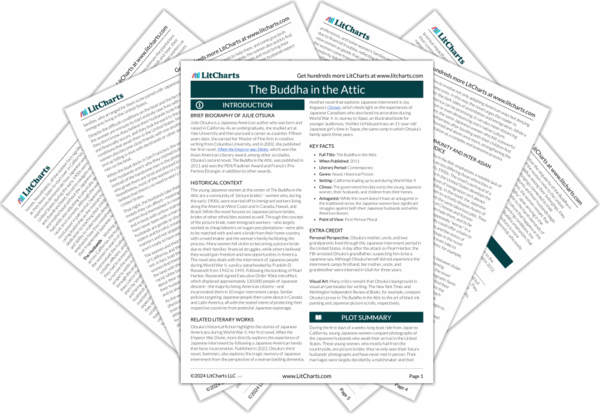The Buddha in the Attic emphasizes a notable lack of community across differing Asian ethnicities in California during the early 1900s. The novel’s portrayal of a fragmented Asian diaspora in the United States develops the idea that the high-stress nature of immigration isn’t always conducive to community-building. In the novel, the Japanese women and their husbands seem to actively despise Asians of other ethnicities, who often work the same laborious jobs. They warn their children to steer clear of Chinese and Korean people, who allegedly dislike or even hate them, and to be mindful around Filipinos, who are supposedly “worse.” In a setting in which inter-Asian community could offer a balm to the isolation of dysfunctional marriages and the stress of physically demanding labor, the Asian groups in the novel remain markedly separate and sometimes even take to harassing one another, with Japanese children, for example, beating up Filipinos as a pastime.
Despite the prejudice and violence that occurs between Asian groups, however, the novel isn’t interested in blaming immigrant populations for such tensions. Rather, the novel serves as a reminder that each group of Asian immigrants faces significant financial and emotional hardship as they find their footing in the United States, and their white bosses are the ones who consistently pit non-white workers against each other in the hopes of finding the cheapest, most efficient laborers. Just as the American-born Japanese children begin to shun their parents’ culture to better conform to white American culture, then, the adult Asian immigrants in the novel take out their frustrations on one another, perhaps as a result of finding themselves constantly subjected to injustice and mistreatment.
Community and Inter-Asian Prejudice ThemeTracker

Community and Inter-Asian Prejudice Quotes in The Buddha in the Attic
They gave themselves new names we had not chosen for them and could barely pronounce […] Many called themselves George. Saburo was called Chinky by all the others because he looked just like a Chinaman. Toshitachi was called Harlem because his skin was so dark.

Unlock explanations and citation info for this and every other The Buddha in the Attic quote.
Plus so much more...
Get LitCharts A+A few of us began receiving anonymous letters in the mail, informing us that our husbands would be next […] Others reported that their husbands had been threatened by angry Filipino workers in the fields […] Hitomi, who had worked as a housekeeper at the Prince estate for more than ten years, was held up at gunpoint in broad daylight as she was heading back into town.











